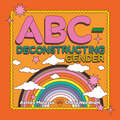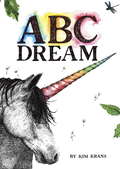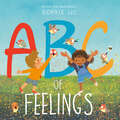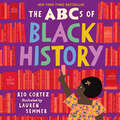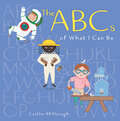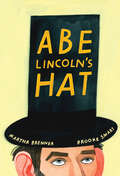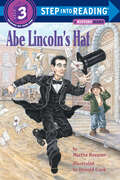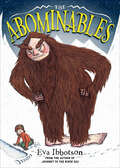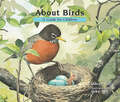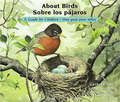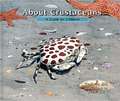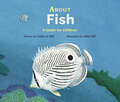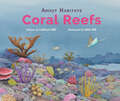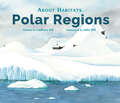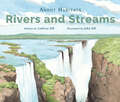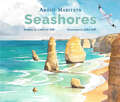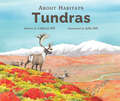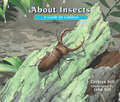- Table View
- List View
ABC-Deconstructing Gender
by Ashley Molesso Chess NeedhamBe affectionate, beautiful, courageous, and more in this gender-bending ABC book. <P><P> Daryl is so affectionate. Alex is gentle with the family cat. Sage and Kaylin are super strong. And Ira yearns to do ballet like their older brother. Demystify gender stereotypes while learning your ABCs in this bright, celebratory debut picture book by stationery company Ash + Chess, who bring not only their quirky artistic flavor but also their personal perspectives as a queer couple to this empowering book for younger kids. This hardcover picture book is rendered in bright, bold colors and patterns and uses neon pink hues throughout. <P><P><i>Advisory: Bookshare has learned that this book offers only partial accessibility. We have kept it in the collection because it is useful for some of our members. Benetech is actively working on projects to improve accessibility issues such as these.</i>
ABC Dream
by Kim KransThis stunning and innovative alphabet picture book will dazzle little ones and engage the adults who share it with them! Each page is dedicated to a letter, and clever alliterations are packed into each ink-and-watercolor spread. This gem comes to us from Kim Krans, the creator of The Wild Unknown--a lifestyle website offering prints, calendars, and more.
ABC of Feelings
by Bonnie LuiThe perfect way for kids to explore the wide range of emotions they feel every day--complete from A to Z with bright, bold illustrations!From anxious to zany, kids experience a wide range of emotions, but they don't often have the language to explain how they're feeling. ABC of Feelings explains that it's perfectly okay--and normal!--to feel many different things, and gives both kids and parents the tools they need to make the abstract nature of feelings and emotions easier to discuss and understand.
ABCs of Baseball
by Peter GolenbockAmerica's favorite pasttime from A to Z. From young to old, new to tried-and-true, here is the baseball book for every fan. With one or more baseball-related terms for each letter arranged in alphabetic order, accompanied by a stirring illustration, this gorgeous compendium celebrates America's game. Large paintings of scenes alternate with scrapbook-style pages. Facts, figures, faces, lists, and other information comprise an additional resource in the back of the book. As contemporary as today's sports page and as nostalgic as an old baseball card, this is an alphabet book for kids, their parents and grandparents that can be used all through the year.
The ABCs of Black History
by Rio CortezA beautiful alphabet picture book that presents key names, moments, and places in Black history with text lyrically written by poet Rio Cortez. This is an opportunity for children to learn their ABCs to the sound of words beyond apple, boy, and cat, and an opportunity for young thinkers to prepare for big ideas.
The ABCs of What I Can Be
by Caitlin McDonaghA fun, imaginative, and boldly illustrated book that gets kids thinking about life's possibilities.A diverse group of children play-acts grown-up occupations, some familiar and others quite far-out. Dressing up in grown-up work clothes, the children try on occupations such as astronaut, artist, archaeologist, and athlete for A and ballerina, beekeeper, biochemist, and bus driver for B to zipper maker, Zumba instructor, and zen gardener for Z. The book is imaginative and joyful and sends out wonderful messages about exploring possibilities while teaching the ABC's.
Abe Lincoln: The Boy Who Loved Books
by Kay Winters Nancy CarpenterLearn about the early life of Abraham Lincoln in this picture book biography that Kirkus Reviews calls “a moving tribute to the power of books and words.” <P><P>In a tiny log cabin a boy listened with delight to the storytelling of his ma and pa. He traced letters in sand, snow, and dust. He borrowed books and walked miles to bring them back. <P><P>When he grew up, he became the sixteenth president of the United States. His name was Abraham Lincoln. <P><P>He loved books. They changed his life. He changed the world. <P><P>Lexile Measure: 700
Abe Lincoln's Hat (Step Into Reading Ser.)
by Martha BrennerWas Abe Lincoln absent-minded? Indeed! President Lincoln came up with a trick involving his stovepipe hat to nudge his memory! Fascinating anecdotes and historical context enrich this expanded biographical picture book that brings to life one of our nation's most revered presidents.Long before he became the 16th president, Abe Lincoln started out as a frontier lawyer. He resorted to sticking letters and notes deep inside his hat so they stayed handy. Adapted from the Step into Reading leveled reader of the same name, author Martha Brenner has revised and enriched her original text to include more historical material and resources for those who want to explore this captivating figure further. Illustrator Brooke Smart's clever art makes history more appealing than ever. Including both humor and painful, hard-hitting American history, this new edition traces Lincoln's evolution into a compelling commander-in-chief during a contentious time in our nation's history. Young readers will be intrigued!
Abe Lincoln's Hat (Step into Reading)
by Martha Brenner Donald CookIllus. in full color. Abraham Lincoln, one of our greatest presidents, started out in life as an absent-minded frontier lawyer. How did he nudge his memory? He stuck letters, court notes, contracts, and even his checkbook in his trademark top hat. When he took off his hat, it was all there!
Abolition is Love
by Ware Syrus MarcusWhat can abolition mean for a child? How can it help them dream a different future for their community?In Abolition is Love, Amelie learns about collective care, mutual aid, and abolitionist ideas as they help their parents get ready for the annual Prisoners&’ Justice Day. Amelie explores big concepts like love, justice, and care, and learns how we can build a different world together through the small choices we make every day. They learn to resolve a conflict with their cousin who plays differently than they do, they help their Papa plan a more accessible park for all, and collectively they create a beautiful banner. Amelie is also excited to hold their own candle at the rally, and they look forward to this big kid moment–to join the ranks of activists calling for justice and abolition. The book explores possibilities for hope, and offers ideas for caring for each other and building communities rooted in social justice and safety for all people. Parents and teachers can engage young readers with the expansive illustrations and prompts that suggest new ways of being in the world together.Abolition is Love!
The Abominables
by Eva IbbotsonRenowned literary great Eva Ibbotson delivers a final novel in her classic, much-loved style. A previously unpublished work from this favorite author, The Abominables follows a family of yetis who are forced, by tourism, to leave their home in the Himalayas and make their way across Europe to a possible new home. Siblings Con and Ellen shepherd the yetis along their eventful journey, with the help of Perry, a good-natured truck driver. Through a mountain rescue in the Alps and a bullfight in Spain, the yetis at last find their way to an ancestral estate in England—only to come upon a club of voracious hunters who have set their sights on the most exotic prey of all: the Abominable Snowmen.
About Birds: A Guide for Children (About. . . #1)
by Cathryn SillAn award-winning, educator-approved first book on birds.In this simple volume, educator and author Cathryn Sill uses clear, easy-to-understand language to teach children what birds are, what they do, and how they live. Noted wildlife illustrator John Sill provides beautifully detailed, realistic paintings to showcase the birds' diverse and natural worlds, and an afterword provides more details about each bird and inspires further learning.
About Birds / Sobre los pájaros: A Guide for Children / Una guía para niños (About. . . #17)
by Cathryn SillAn award-winning, educator-approved first book on birds.In this simple volume, educator and author Cathryn Sill uses clear, easy-to-understand language to teach children what birds are, what they do, and how they live. Noted wildlife illustrator John Sill provides beautifully detailed, realistic paintings to showcase the birds' diverse and natural worlds, and an afterword provides more details about each bird and inspires further learning.
About Crustaceans: A Guide for Children (Fountas & Pinnell LLI Blue #Level K)
by Cathryn SillDescribes the anatomy, behavior, and habitat of various crustaceans, including the lobster, crab, and shrimp.
About Earth
by Pauline CartwrightPacked with amazing facts, you can wow your friends with everything you know about Earth.
About Fish: A Guide for Children (About. . . #6)
by Cathryn SillThis award-winning beginner's guide to the natural world of fish from the creators of the About... series was named an "NSTA Recommends" book. Noted educator and author Cathryn Sill uses simple, easy-to-understand language to teach children the basic characteristics of what fish are, how they swim, breathe, and reproduce, and explains the different ways they protect themselves from predators. With beautifully detailed, realistic paintings, noted wildlife illustrator John Sill introduces readers to the diversity of the fish population, from an Arctic char to a porcupine fish. An afterword provides more details, inspiring further learning. This book is ideal for early childhood and elementary units in science, environment, and marine life.
About Fish / Sobre los peces: A Guide for Children / Una guía para niños (About. . . #21)
by Cathryn SillThis award-winning beginner's guide to the natural world of fish from the creators of the About... series was named an "NSTA Recommends" book. Noted educator and author Cathryn Sill uses simple, easy-to-understand language to teach children the basic characteristics of what fish are, how they swim, breathe, and reproduce, and explains the different ways they protect themselves from predators. With beautifully detailed, realistic paintings, noted wildlife illustrator John Sill introduces readers to the diversity of the fish population, from an Arctic char to a porcupine fish. An afterword provides more details, inspiring further learning. This book is ideal for early childhood and elementary units in science, environment, and marine life.
About Habitats: Coral Reefs (About Habitats)
by Cathryn SillThis beginner&’s guide introduces coral reefs to young learners (PK-2) and showcases the diversity of wildlife found around the world in these complex ecosystemsABOUT HABITATS: CORAL REEFS is an engaging first glimpse into this unique habitat. In simple terms, author and former teacher Cathryn Sill explains what corals are and how reefs are built, describes the characteristics of some of the world&’s major coral reefs, and highlights some of the many species of animals and plants that have adapted to life in these fragile environments. Detailed illustrations by award-winning wildlife artist John Sill depict a variety of coral reefs, from the Great Barrier Reef in the Pacific Ocean to the Red Sea Reef in the Indian Ocean. The colorful, detailed paintings bring the coral reefs to life for young naturalists.A map, an afterword, and a glossary provide more detailed information about coral reefs in general and about the wildlife featured in the illustrations.
About Habitats: Polar Regions (About Habitats #7)
by Cathryn SillThis beginner's guide and classroom favorite explores the Arctic and Antarctic biomes, their beauty, and global diversity. Author and former early education teacher Cathryn Sill uses simple, easy-to-understand language to teach children what the Polar Regions are—from the frozen deserts of Antarctica to the ice floes of the Arctic Ocean—along with what kinds of animals and plants live there, how they have adapted to life in this environment, and why they're important. Noted wildlife illustrator John Sill offers full-color illustrations depicting the various landscapes and species of animals and plants. A glossary and afterword provide more details for further study. Great for early childhood and elementary units on geography and habitats, nature and environment.
About Habitats: Rivers and Streams
by Cathryn SillA perfect entry for first conversations about waterways and conservation.Author and illustrator team Cathryn and John Sill offer an accessible introduction to rivers and streams, touching on their major attributes, the animals and plants that live there, and their remarkable global diversity. Using simple, easy-to-understand language, the author teaches children what rivers and streams are and explains how various species of animals and plants have adapted to life in or along these waterways. Detailed, full-color art shows the characteristics of the world's different rivers and streams―from the mountain brooks of the Alps to the mighty Amazon River in South America. A glossary and afterword provide further details. Great for casual exploration and for early childhood and elementary education units on nature, environment, earth sciences, and ecosystems.
About Habitats: Seashores (About Habitats Ser. #8)
by Cathryn SillStudying nature? Going to the beach? Dig into this classroom favorite and beginner's guide to seashores from the creators of the award-winning About Habitats series.In this accessible introduction to a familiar locale, author and educator Cathryn Sill uses simple, easy-to-understand language to teach children about seashores and their diversity, the types of animals and plants that live there, and why they're important. The stunning paintings by noted wildlife illustrator John Sill depict the wide variety of seashore topography. A glossary and afterword provide more details about each seashore featured in the book. Perfect for early childhood and elementary units on nature, environment, and ecosystems.
About Habitats: Tundras (About Habitats #10)
by Cathryn SillThis beginner's guide to tundras explores the unique attributes of this cold habitat, showcasing its beauty and plant and animal diversity. Author and educator Cathryn Sill uses simple, easy-to-understand language to teach children what tundras are, what kinds of animals and plants live there, and how certain species have adapted to the unique environment. The book covers the characteristics of Arctic, Antarctic, and alpine tundras. John Sill's detailed, realistic paintings reflect the beauty and diversity of the habitat. A glossary and afterword provide more detail for further exploration. Ideal for early childhood and elementary education units on biomes and environments, geography, habitats, and nature.
About Hummingbirds: A Guide for Children (About. . . #14)
by Cathryn SillAn award-winning first glimpse into the world of hummingbirds.In this addition to the acclaimed About... series, author and educator Cathryn Sill uses simple, easy-to-understand language to teach children what hummingbirds are, how they look, how they move, what they eat, and where they live. The beautifully detailed, realistic paintings of noted wildlife illustrator John Sill introduce readers to the many varieties of hummingbirds—from the smallest type (the bee hummingbirds of Cuba) to the largest (the giant hummingbirds of the Andes Mountains in South America). An afterword inspires further learning. This beginner's guide to hummingbirds is perfect for early childhood and elementary units in science and animal life.
About Insects: A Guide for Children (About. . . #4)
by Cathryn SillThis beginner's guide to insects is a must-have for bug-obsessed young learners as well as for those who are simply curious about these creatures. In this addition to the acclaimed About... series, author and educator Cathryn Sill uses simple, easy-to-understand language to teach children what insects are, how they look, how they move, what they eat, and where they live. With beautifully detailed, realistic paintings, noted wildlife illustrator John Sill introduces readers to a wide variety of insects, from ants and beetles to grasshoppers and the monarch butterfly. An afterword provides further details, inspiring young readers to learn more.
About Insects / Sobre los insectos: A Guide for Children / Una guía para niños (About. . . #18)
by Cathryn SillThis beginner's guide to insects is a must-have for bug-obsessed young learners as well as for those who are simply curious about these creatures. In this addition to the acclaimed About... series, author and educator Cathryn Sill uses simple, easy-to-understand language to teach children what insects are, how they look, how they move, what they eat, and where they live. With beautifully detailed, realistic paintings, noted wildlife illustrator John Sill introduces readers to a wide variety of insects, from ants and beetles to grasshoppers and the monarch butterfly. An afterword provides further details, inspiring young readers to learn more.
